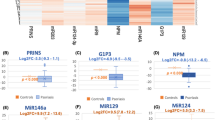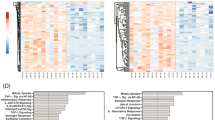Abstract
Background
Psoriasis is an immune-mediated disease with interactions between genetic and environmental factors. An increasing number of studies are demonstrating the importance of microRNAs (miRNAs) in the pathogenesis of psoriasis. miR-146a, a dominant negative regulator of inflammation, has been consistently reported as overexpressed in the skin and peripheral blood mononuclear cells (PBMCs) of patients with psoriasis. Expression and/or function of this miRNA is highly influenced by genetic variations, some of which have already been associated with susceptibility to psoriasis.
Objective
We sought to study the importance of miR-146a in patients with moderate-to-severe psoriasis and to understand the impact of rs57095329 and rs2910164 polymorphisms in a psoriatic Portuguese population.
Methods
miR-146a circulating levels were quantified using molecular biology techniques in 99 patients with moderate-to-severe psoriasis (35 female, 64 male; age 47.4 ± 10.9 years) and 78 healthy individuals (52 female, 26 male; age 42.4 ± 10.1 years). miRNA expression was correlated with clinicopathological features as well as with genetic data such as the presence of human leukocyte antigen (HLA)-C*0602 allele and two miR-146a polymorphisms (rs2910164 and rs57095329).
Results
miR-146a serum levels were 3.7-fold higher in patients with psoriasis than in controls (p < 0.0001, area under the curve [AUC] 0.75; 95% confidence interval [CI] 0.66–0.83). Of note, miR-146a circulating levels positively correlated with Psoriasis Area and Severity Index (p < 0.05) and body surface area (p < 0.05) indexes. No variations in miR-146a levels were observed with rs2910164 and rs57095329 genotypes.
Conclusion
Circulating miR-146a levels were upregulated in patients with psoriasis, especially in those with active disease. To the best of our knowledge, this is the largest study with a homogenous psoriasis population, and our data could shed light on the pathogenesis of psoriasis, paving the way for new avenues for disease treatment.



Similar content being viewed by others
References
Christophers E. Psoriasis—epidemiology and clinical spectrum. Clin Exp Dermatol. 2001;26(4):314–20. https://doi.org/10.1046/j.1365-2230.2001.00832.x.
Kaushik SB, Lebwohl MG. Psoriasis: which therapy for which patient: Psoriasis comorbidities and preferred systemic agents. J Am Acad Dermatol. 2019;80(1):27–40. https://doi.org/10.1016/j.jaad.2018.06.057.
Mustonen A, Mattila K, Leino M, Koulu L, Tuominen R. Psoriasis causes significant economic burden to patients. Dermatol Ther (Heidelb). 2014;4(1):115–24. https://doi.org/10.1007/s13555-014-0053-2.
Tampa M, Sarbu MI, Mitran MI, Mitran CI, Matei C, Georgescu SR. The pathophysiological mechanisms and the quest for biomarkers in psoriasis, a stress-related skin disease. Dis Mark. 2018;2018:5823684. https://doi.org/10.1155/2018/5823684.
Hawkes JE, Chan TC, Krueger JG. Psoriasis pathogenesis and the development of novel targeted immune therapies. J Allergy Clin Immunol. 2017;140(3):645–53. https://doi.org/10.1016/j.jaci.2017.07.004.
Capon F. The genetic basis of psoriasis. Int J Mol Sci. 2017. https://doi.org/10.3390/ijms18122526.
Greb JE, Goldminz AM, Elder JT, Lebwohl MG, Gladman DD, Wu JJ, et al. Psoriasis. Nat Rev Dis Prim. 2016;2:16082. https://doi.org/10.1038/nrdp.2016.82.
Mahil SK, Capon F, Barker JN. Genetics of psoriasis. Dermatol Clin. 2015;33(1):1–11. https://doi.org/10.1016/j.det.2014.09.001.
Hwang ST, Nijsten T, Elder JT. Recent highlights in psoriasis research. J Investig Dermatol. 2017;137(3):550–6. https://doi.org/10.1016/j.jid.2016.11.007.
Ogawa K, Okada Y. The current landscape of psoriasis genetics in 2020. J Dermatol Sci. 2020;99(1):2–8. https://doi.org/10.1016/j.jdermsci.2020.05.008.
Alshobaili HA, Shahzad M, Al-Marshood A, Khalil A, Settin A, Barrimah I. Genetic background of psoriasis. Int J Health Sci (Qassim). 2010;4(1):23–9.
Hawkes JE, Nguyen GH, Fujita M, Florell SR, Callis Duffin K, Krueger GG, et al. microRNAs in psoriasis. J Investig Dermatol. 2016;136(2):365–71. https://doi.org/10.1038/JID.2015.409.
Reolid A, Munoz-Aceituno E, Abad-Santos F, Ovejero-Benito MC, Dauden E. Epigenetics in non-tumor immune-mediated skin diseases. Mol Diagn Ther. 2021;25(2):137–61. https://doi.org/10.1007/s40291-020-00507-1.
Goldberg AD, Allis CD, Bernstein E. Epigenetics: a landscape takes shape. Cell. 2007;128(4):635–8. https://doi.org/10.1016/j.cell.2007.02.006.
Frischknecht L, Vecellio M, Selmi C. The role of epigenetics and immunological imbalance in the etiopathogenesis of psoriasis and psoriatic arthritis. Ther Adv Musculoskelet Dis. 2019;11:1759720X19886505. https://doi.org/10.1177/1759720X19886505.
Liu Y, Liu Q. MicroRNAs as regulatory elements in psoriasis. Open Med (Wars). 2016;11(1):336–40. https://doi.org/10.1515/med-2016-0063.
Du T, Zamore PD. microPrimer: the biogenesis and function of microRNA. Development. 2005;132(21):4645–52. https://doi.org/10.1242/dev.02070.
Brennecke J, Stark A, Russell RB, Cohen SM. Principles of microRNA-target recognition. PLoS Biol. 2005;3(3):e85. https://doi.org/10.1371/journal.pbio.0030085.
Liu Q, Wu DH, Han L, Deng JW, Zhou L, He R, et al. Roles of microRNAs in psoriasis: immunological functions and potential biomarkers. Exp Dermatol. 2017;26(4):359–67. https://doi.org/10.1111/exd.13249.
O’Connell RM, Rao DS, Baltimore D. microRNA regulation of inflammatory responses. Annu Rev Immunol. 2012;30:295–312. https://doi.org/10.1146/annurev-immunol-020711-075013.
Singhvi G, Manchanda P, Krishna Rapalli V, Kumar Dubey S, Gupta G, Dua K. MicroRNAs as biological regulators in skin disorders. Biomed Pharmacother. 2018;108:996–1004. https://doi.org/10.1016/j.biopha.2018.09.090.
Xiao S, Liu X, Wang X, Lv H, Zhao J, Guo X, et al. Plasma microRNA expression profiles in psoriasis. J Immunol Res. 2020;2020:1561278. https://doi.org/10.1155/2020/1561278.
Xiong Y, Chen H, Liu L, Lu L, Wang Z, Tian F, et al. microRNA-130a promotes human keratinocyte viability and migration and inhibits apoptosis through direct regulation of STK40-mediated NF-kappaB pathway and indirect regulation of SOX9-meditated JNK/MAPK pathway: a potential role in psoriasis. DNA Cell Biol. 2017;36(3):219–26. https://doi.org/10.1089/dna.2016.3517.
Mensa E, Recchioni R, Marcheselli F, Giuliodori K, Consales V, Molinelli E, et al. MiR-146a-5p correlates with clinical efficacy in patients with psoriasis treated with the tumour necrosis factor-alpha inhibitor adalimumab. Br J Dermatol. 2018;179(3):787–9. https://doi.org/10.1111/bjd.16659.
Sonkoly E, Stahle M, Pivarcsi A. MicroRNAs: novel regulators in skin inflammation. Clin Exp Dermatol. 2008;33(3):312–5. https://doi.org/10.1111/j.1365-2230.2008.02804.x.
Srivastava A, Nikamo P, Lohcharoenkal W, Li D, Meisgen F, Xu Landen N, et al. MicroRNA-146a suppresses IL-17-mediated skin inflammation and is genetically associated with psoriasis. J Allergy Clin Immunol. 2017;139(2):550–61. https://doi.org/10.1016/j.jaci.2016.07.025.
Xia P, Fang X, Zhang ZH, Huang Q, Yan KX, Kang KF, et al. Dysregulation of miRNA146a versus IRAK1 induces IL-17 persistence in the psoriatic skin lesions. Immunol Lett. 2012;148(2):151–62. https://doi.org/10.1016/j.imlet.2012.09.004.
Zhang W, Yi X, Guo S, Shi Q, Wei C, Li X, et al. A single-nucleotide polymorphism of miR-146a and psoriasis: an association and functional study. J Cell Mol Med. 2014;18(11):2225–34. https://doi.org/10.1111/jcmm.12359.
Gong HB, Zhang SL, Wu XJ, Pu XM, Kang XJ. Association of rs2910164 polymorphism in MiR-146a gene with psoriasis susceptibility: a meta-analysis. Medicine (Baltimore). 2019;98(6):e14401. https://doi.org/10.1097/MD.0000000000014401.
Park R, Lee WJ, Ji JD. Association between the three functional miR-146a single-nucleotide polymorphisms, rs2910164, rs57095329, and rs2431697, and autoimmune disease susceptibility: a meta-analysis. Autoimmunity. 2016;49(7):451–8. https://doi.org/10.3109/08916934.2016.1171854.
Jazdzewski K, Murray EL, Franssila K, Jarzab B, Schoenberg DR, de la Chapelle A. Common SNP in pre-miR-146a decreases mature miR expression and predisposes to papillary thyroid carcinoma. Proc Natl Acad Sci USA. 2008;105(20):7269–74. https://doi.org/10.1073/pnas.0802682105.
Luo X, Yang W, Ye DQ, Cui H, Zhang Y, Hirankarn N, et al. A functional variant in microRNA-146a promoter modulates its expression and confers disease risk for systemic lupus erythematosus. PLoS Genet. 2011;7(6):e1002128. https://doi.org/10.1371/journal.pgen.1002128.
Wang G, Tam LS, Li EK, Kwan BC, Chow KM, Luk CC, et al. Serum and urinary cell-free MiR-146a and MiR-155 in patients with systemic lupus erythematosus. J Rheumatol. 2010;37(12):2516–22. https://doi.org/10.3899/jrheum.100308.
Bunce M, O’Neill CM, Barnardo MC, Krausa P, Browning MJ, Morris PJ, et al. Phototyping: comprehensive DNA typing for HLA-A, B, C, DRB1, DRB3, DRB4, DRB5 & DQB1 by PCR with 144 primer mixes utilizing sequence-specific primers (PCR-SSP). Tissue Antigens. 1995;46(5):355–67. https://doi.org/10.1111/j.1399-0039.1995.tb03127.x.
Livak KJ, Schmittgen TD. Analysis of relative gene expression data using real-time quantitative PCR and the 2(-Delta Delta C(T)) method. Methods. 2001;25(4):402–8. https://doi.org/10.1006/meth.2001.1262.
Chen XM, Zhao Y, Wu XD, Wang MJ, Yu H, Lu JJ, et al. Novel findings from determination of common expressed plasma exosomal microRNAs in patients with psoriatic arthritis, psoriasis vulgaris, rheumatoid arthritis, and gouty arthritis. Discov Med. 2019;28(151):47–68.
Lovendorf MB, Zibert JR, Gyldenlove M, Ropke MA, Skov L. MicroRNA-223 and miR-143 are important systemic biomarkers for disease activity in psoriasis. J Dermatol Sci. 2014;75(2):133–9. https://doi.org/10.1016/j.jdermsci.2014.05.005.
Chiricozzi A, Nograles KE, Johnson-Huang LM, Fuentes-Duculan J, Cardinale I, Bonifacio KM, et al. IL-17 induces an expanded range of downstream genes in reconstituted human epidermis model. PLoS ONE. 2014;9(2):e90284. https://doi.org/10.1371/journal.pone.0090284.
Harden JL, Krueger JG, Bowcock AM. The immunogenetics of psoriasis: a comprehensive review. J Autoimmun. 2015;64:66–73. https://doi.org/10.1016/j.jaut.2015.07.008.
Martin DA, Towne JE, Kricorian G, Klekotka P, Gudjonsson JE, Krueger JG, et al. The emerging role of IL-17 in the pathogenesis of psoriasis: preclinical and clinical findings. J Invest Dermatol. 2013;133(1):17–26. https://doi.org/10.1038/jid.2012.194.
Saba R, Sorensen DL, Booth SA. MicroRNA-146a: a dominant, negative regulator of the innate immune response. Front Immunol. 2014;5:578. https://doi.org/10.3389/fimmu.2014.00578.
Meisgen F, Xu Landen N, Wang A, Rethi B, Bouez C, Zuccolo M, et al. MiR-146a negatively regulates TLR2-induced inflammatory responses in keratinocytes. J Investig Dermatol. 2014;134(7):1931–40. https://doi.org/10.1038/jid.2014.89.
Niimoto T, Nakasa T, Ishikawa M, Okuhara A, Izumi B, Deie M, et al. MicroRNA-146a expresses in interleukin-17 producing T cells in rheumatoid arthritis patients. BMC Musculoskelet Disord. 2010;11:209. https://doi.org/10.1186/1471-2474-11-209.
Yang L, Boldin MP, Yu Y, Liu CS, Ea CK, Ramakrishnan P, et al. miR-146a controls the resolution of T cell responses in mice. J Exp Med. 2012;209(9):1655–70. https://doi.org/10.1084/jem.20112218.
Fan X, Yang S, Sun LD, Liang YH, Gao M, Zhang KY, et al. Comparison of clinical features of HLA-Cw*0602-positive and -negative psoriasis patients in a Han Chinese population. Acta Derm Venereol. 2007;87(4):335–40. https://doi.org/10.2340/00015555-0253.
Gudjonsson JE, Karason A, Runarsdottir EH, Antonsdottir AA, Hauksson VB, Jonsson HH, et al. Distinct clinical differences between HLA-Cw*0602 positive and negative psoriasis patients—an analysis of 1019 HLA-C- and HLA-B-typed patients. J Investig Dermatol. 2006;126(4):740–5. https://doi.org/10.1038/sj.jid.5700118.
Hermann H, Runnel T, Aab A, Baurecht H, Rodriguez E, Magilnick N, et al. miR-146b probably assists miRNA-146a in the suppression of keratinocyte proliferation and inflammatory responses in psoriasis. J Investig Dermatol. 2017;137(9):1945–54. https://doi.org/10.1016/j.jid.2017.05.012.
Maharaj AB, Naidoo P, Ghazi T, Abdul NS, Dhani S, Docrat TF, et al. MiR-146a G/C rs2910164 variation in South African Indian and Caucasian patients with psoriatic arthritis. BMC Med Genet. 2018;19(1):48. https://doi.org/10.1186/s12881-018-0565-1.
Chatzikyriakidou A, Voulgari PV, Georgiou I, Drosos AA. The role of microRNA-146a (miR-146a) and its target IL-1R-associated kinase (IRAK1) in psoriatic arthritis susceptibility. Scand J Immunol. 2010;71(5):382–5. https://doi.org/10.1111/j.1365-3083.2010.02381.x.
Acknowledgements
The authors acknowledge the patients followed at HSA-CHUP. We also acknowledge the nurses from the Dermatology outpatient clinic and Mrs Dina Lopes for collaboration in sample collection and Ms. Maria Rebelo for technical assistance.
Author information
Authors and Affiliations
Corresponding author
Ethics declarations
Funding
No sources of funding were used to conduct this study or prepare this manuscript.
Conflict of interest
Bárbara Leal, Cláudia Carvalho, Ana Marta Ferreira, Miguel Nogueira, Sandra Brás, Berta M. Silva, Manuela Selores, Paulo P. Costa, and Tiago Torres have no conflicts of interest that are directly relevant to the content of this article.
Availability of Data and Material
Not applicable.
Ethics approval
The study was approved by the hospital Institutional Ethical Committee.
Consent
Written informed consent was obtained from every participant in the study in accordance with Helsinki Declaration.
Author contributions
The study was conceived and designed by Bárbara Leal, Cláudia Carvalho, and Tiago Torres. Material preparation and data collection and analysis were performed by Bárbara Leal, Cláudia Carvalho, Ana Marta, Miguel Nogueira, and Sandra Brás. The first draft of the manuscript was written by Bárbara Leal and Cláudia Carvalho. Miguel Nogueira, Berta M. Silva, Manuela Selores, Paulo Pinho e Costa, and Tiago Torres critically revised the manuscript, and the final version was read and approved by all authors.
Rights and permissions
About this article
Cite this article
Leal, B., Carvalho, C., Ferreira, A.M. et al. Serum Levels of miR-146a in Patients with Psoriasis. Mol Diagn Ther 25, 475–485 (2021). https://doi.org/10.1007/s40291-021-00531-9
Accepted:
Published:
Issue Date:
DOI: https://doi.org/10.1007/s40291-021-00531-9




